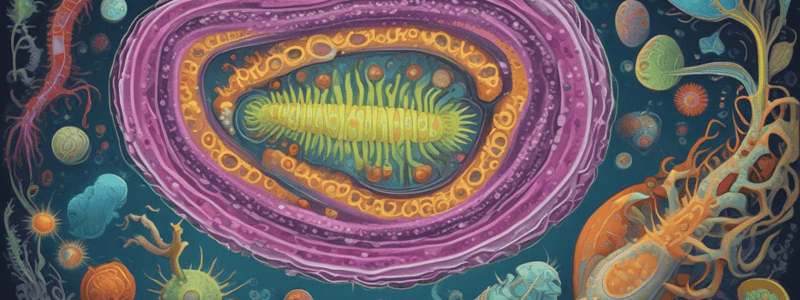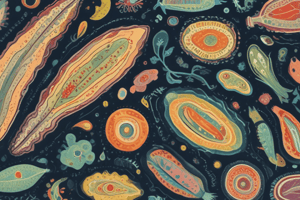Podcast
Questions and Answers
What is the genus of the protozoan Giardia lamblia?
What is the genus of the protozoan Giardia lamblia?
- Trypanosoma
- Leishmania
- Giardia (correct)
- Plasmodium
What is the mode of transmission of Giardia lamblia?
What is the mode of transmission of Giardia lamblia?
- Contaminated air
- Direct contact with infected individuals
- Fecal-oral route (correct)
- Insect vectors
What is the shape of Giardia lamblia?
What is the shape of Giardia lamblia?
- Oval
- Pear-shaped (correct)
- Cylindrical
- Spherical
How many nuclei does Giardia lamblia have?
How many nuclei does Giardia lamblia have?
What is the phylum of Giardia lamblia?
What is the phylum of Giardia lamblia?
What is the typical length of Giardia lamblia?
What is the typical length of Giardia lamblia?
What is the characteristic feature of Giardia lamblia's cytoplasm?
What is the characteristic feature of Giardia lamblia's cytoplasm?
What is the typical width of Giardia lamblia?
What is the typical width of Giardia lamblia?
What is the number of flagella in Giardia lamblia?
What is the number of flagella in Giardia lamblia?
What is the characteristic movement of Trichomonas vaginalis trophozoite?
What is the characteristic movement of Trichomonas vaginalis trophozoite?
What is the common stain used for detecting trophozoite in Papanicolau smear?
What is the common stain used for detecting trophozoite in Papanicolau smear?
What is the method used for isolating Trichomonas vaginalis from vaginal and urethral discharge?
What is the method used for isolating Trichomonas vaginalis from vaginal and urethral discharge?
What is the treatment for Trichomonas vaginalis infection?
What is the treatment for Trichomonas vaginalis infection?
What is the mode of transmission of Dientamoeba fragilis?
What is the mode of transmission of Dientamoeba fragilis?
What is the site of infection of Dientamoeba fragilis?
What is the site of infection of Dientamoeba fragilis?
What is the disease caused by Dientamoeba fragilis?
What is the disease caused by Dientamoeba fragilis?
What is the characteristic feature of Dientamoeba fragilis morphology?
What is the characteristic feature of Dientamoeba fragilis morphology?
What is the symptom of Dientamoeba fragilis infection?
What is the symptom of Dientamoeba fragilis infection?
What is the shape of Giardia lamblia cysts?
What is the shape of Giardia lamblia cysts?
What is the diameter of Giardia lamblia cysts?
What is the diameter of Giardia lamblia cysts?
How many nuclei are present in a mature Giardia lamblia cyst?
How many nuclei are present in a mature Giardia lamblia cyst?
What is the route of infection for Giardia lamblia?
What is the route of infection for Giardia lamblia?
What is the location of Giardia lamblia trophozoites in the small intestine?
What is the location of Giardia lamblia trophozoites in the small intestine?
What is the process by which Giardia lamblia trophozoites multiply?
What is the process by which Giardia lamblia trophozoites multiply?
What is the stage of Giardia lamblia that is commonly found in nondiarrheal faeces?
What is the stage of Giardia lamblia that is commonly found in nondiarrheal faeces?
Why is person-to-person transmission of Giardia lamblia possible?
Why is person-to-person transmission of Giardia lamblia possible?
What is the process by which Giardia lamblia trophozoites transform into cysts?
What is the process by which Giardia lamblia trophozoites transform into cysts?
What is the characteristic of the cyst stage of Balantidium coli?
What is the characteristic of the cyst stage of Balantidium coli?
What is the natural host of Balantidium coli?
What is the natural host of Balantidium coli?
What is the site of infection of Balantidium coli?
What is the site of infection of Balantidium coli?
What is the treatment for Balantidium coli infection?
What is the treatment for Balantidium coli infection?
What is the diagnostic method for Balantidium coli infection?
What is the diagnostic method for Balantidium coli infection?
What is the classification of Balantidium coli?
What is the classification of Balantidium coli?
What is the pathogenesis of Balantidium coli infection?
What is the pathogenesis of Balantidium coli infection?
What is the characteristic of the trophozoite stage of Balantidium coli?
What is the characteristic of the trophozoite stage of Balantidium coli?
What is the reproductive method of Balantidium coli?
What is the reproductive method of Balantidium coli?
What is the characteristic of Leishmania as an obligate intracellular parasite?
What is the characteristic of Leishmania as an obligate intracellular parasite?
Which of the following is the mode of transmission of Leishmania?
Which of the following is the mode of transmission of Leishmania?
What is the site of infection for Leishmania in human hosts?
What is the site of infection for Leishmania in human hosts?
What is the characteristic of the amastigote form of Leishmania?
What is the characteristic of the amastigote form of Leishmania?
Which of the following is a type of leishmaniasis?
Which of the following is a type of leishmaniasis?
What is the diagnostic method for Leishmania infection?
What is the diagnostic method for Leishmania infection?
What is the treatment for Leishmania infection?
What is the treatment for Leishmania infection?
What is the insect vector responsible for transmitting Leishmania?
What is the insect vector responsible for transmitting Leishmania?
What is the characteristic of the promastigote form of Leishmania?
What is the characteristic of the promastigote form of Leishmania?
Flashcards are hidden until you start studying
Study Notes
Intestinal and Atrial Flagellates and Ciliates
Giardia lamblia
- Distribution: Worldwide, particularly in England, Russia, and several countries in Eastern Europe and many seaside areas of the Mediterranean
- Found in lakes, streams, and other water sources
- Kingdom: Protista
- Subkingdom: Protozoa
- Phylum: Sarcomastigophora
- Subphylum: Mastigophora
- Class: Zommastigophora
- Order: Diplomonadida
- Family: Hexamitidae
- Genus: Giardia
- Species: lamblia
- Transmission: Fecal-oral route, ingestion of food and water contaminated with animal or human feces
- Morphology: Pear-shaped, 9-21 mm in length, 5-15 mm in width, bilaterally symmetrical, 2 nuclei, and 2 median parabasal bodies
- Structure: Fine granular cytoplasm and 2 flagella
- Life cycle: Excystation, encystation, and infection occurs by the ingestion of cysts in contaminated water, food, or by the fecal-oral route
Trichomonas vaginalis
- Morphology: Oval and lightly bile-stained, 8-12 mm in diameter, 4 nuclei (mature), and small eccentric karyosome
- Transmission: Fecal-oral route, ingestion of contaminated water, food, or by the fecal-oral route
- Detection: Direct smear microscopy, Papanicolau smear, and immunofluorescent stain
- Treatment: Metronidazole (topical and systemic) and sexual partner treatment to prevent recurrence of infection
- Prevention: Detection and treatment of cases, avoiding unprotected sexual contact, and no vaccine available
Dientamoeba fragilis
- Morphology: Binucleate form, spindle structure between the two nuclei
- Site of infection: Gastrointestinal tract
- Route: Oral-fecal transmission
- Symptoms: Diarrhea, abdominal pain, flatulence, nausea, and fatigue
- Disease: Dientamoebiasis
- Diagnosis: Microscopic examination of stool, trichrome stain, and PCR
- Treatment: Metronidazole
Balantidium coli
- Phylum: Ciliophora
- Family: Balantididae
- Natural host: Pigs
- Accidental host: Humans
- Reservoirs: Monkeys, pigs, and rats
- Site: Large intestine
- Morphology: Trophozoite (active motile, short delicate cilia over the entire surface of the body, 2 nucleus, large kidney-shaped macronucleus, and small micronucleus) and cyst (spherical, 2 nucleus, and surrounded by a thick and transparent double-layered wall)
- Pathogenesis: Mucosal ulcers and submucosal abscesses
- Diagnosis: Stool examination and biopsy (intestinal ulcers)
- Treatment: Tetracycline, metronidazole, and nitroimidazole
Blood and Tissue Flagellates
Leishmania spp.
- Obligate intracellular parasite
- 2 hosts: Mammalian and insect vector (female sandfly)
- Site: Macrophages (human and other mammalian)
- Mode of transmission: Blood-sucking sandflies
- Morphology: Amastigote form (ovoid body, nucleus, kinetoplast, non-motile, and no flagellum) and promastigote form (spindle shape body, single flagellum, motile)
- Pathogenesis: Cutaneous leishmaniasis, mucocutaneous leishmaniasis, and visceral leishmaniasis (liver and spleen)
- Diagnosis: Biopsy (intestinal ulcers), cultures (nutrient agar + blood), and serological and molecular tests
- Treatment: Pentavalent antimonials (sodium stibogluconate or meglumine antimonate)
Studying That Suits You
Use AI to generate personalized quizzes and flashcards to suit your learning preferences.




